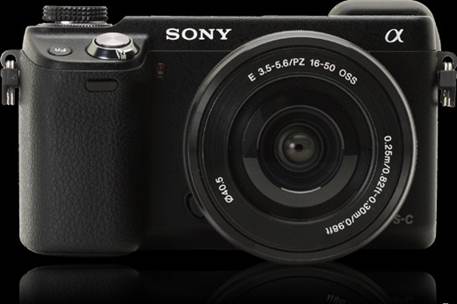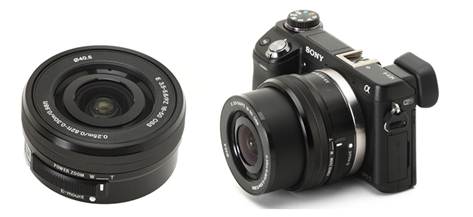Since the smartphone market still keeps on affecting sales of
compact cameras these days, we found that the camera manufacturers increasingly
pay their attention to a smaller market - but with more potential - group.
Specifically, those who are passionate about photography would like to get a
more compact DSLR alternative, but still require the level of customization and
camera control that they have become accustomed.

Rating based on
the NEX-6 product with firmware v.1.01
Accordingly, the past several years have witnessed a series
of cameras with high technological lenses that are likely to substitute for
each other such as the Sony NEX-7, the Olympus OM-D E-M5, Panasonic DMC-GX-1
and Fujifilm X-E1, which in terms of the prices and features are aimed at
surpassing far the point and shoot quality upgraders (ironically, these are the
criteria that were originally thought to be most beneficial for the ILC
manufacturers)
With the release of the NEX-6, Sony seems to have adjusted
the hi-endconcept by combining much of the technologies of the NEX-7 with the
connectivity options of the NEX-5R. In essence, the NEX-6 combines the
highlights of a camera oriented for photography enthusiasts - the control dials
with a high quality viewfinder - with the Wi-Fi feature and applications. But
strangely, though it has created a camera that is clearly designed to attract
the people who own smartphones, Sony has eliminated the operation of the touch
screen found in the NEX-5N and 5R.
The outstanding specifications of the Sony NEX-6
·
16.1MP APS-C format CMOS sensor (23.5 x 15.6 mm)
·
2.3 million dot resolution OLED EVF
·
ISO 100-25,600
·
Control dial
·
Customizable Fn button
·
'Quick Navi' interactive display settings
·
Multi interface hotshoe (supports standard contacts and
proprietary connector)
·
Integrated Wi-Fi for connection to smartphones or computers, for
image sharing
·
Proprietary in-camera apps
·
Integrated flash (GN 6, ISO 100)
·
Electronic 1st Curtain shutter
·
1,080/60p HD movies in AVCHD (50p on PAL region models)
The NEX-6 and NEX-7 are very similar to each other in terms
of both appearance and specifications (for the NEX-7 24MP sensor) so many
people may wonder whether the flagship model
is still relevant. The NEX-6 is equipped with the same great 2.3 million dot
OLED EVF, an integrated flash, 1,080/60p video, and even supplements an
exposure mode dial and (eventually) an ISO standard hotshoe connection. It also
features the NEX-5R's hybrid phase/contrast-detection AF system. The NEX-6 is
still lacking the Tri-Navi three-dial controls of the NEX-7, but this seems
unable to be a factor causing most of the photographers to refuse this camera.
A few small features of the NEX-7 have been reduced such as 3D panoramas,
automatic LCD brightness adjustment, and a number of creative types.
Now it is in terms of the hydrid auto-focus system (AF
hybrid). The NEX-6, like the NEX-5R, uses a modified CMOS sensor that is able
to regulate pixels reserved for implementing phase-detection techniques to provide
a hybrid autofocus system automatically. The phase-detection pixels are used to
define detailed information about the focus target; this means that the camera
has to perform less hunting to get the precise focus. Sony is the fourth
manufacturer (following Fujifilm, Nikon and Canon) to go down this path, with
the potential of faster focus; continuous focus performance is improved and
autofocus is better in the movie mode. The NEX-6 has 99 phase detection 'AF
points', located along the middle range of the frame.
And as with the NEX-5R, the NEX-6 features integrated
DLNA-compliant Wi-Fi and the on-camera applications. While the collection of
applications is quite limited at this moment (currently only eight apps are
available), Sony has made it clear that they plan to expand the supplies in
the near future. And the ability to increase the current capacities of your
camera through friendly app downloads for users; as contrary to the firmware
updates is a significant thing that is likely worth being expected.
The Wi-Fi capability enables you to push the images from the
NEX-6 to an iOS or Android smartphone, to your Mac or PC, or straight to
Facebook (or Sony’s PlayMemories site) via a Wi-Fi network. You are also able
to make use of your smartphone as a remote viewfinder/button. We've included
the connectivity options of the NEX-6 in detail here.
E-mount power zoom 16-50mm F3.5-5.6 OSS
Along with the NEX-6, Sony has recommended the E PZ 16-50mm
F3.5-5.6 OSS power zoom lens. The zoom design is likely to be retractable just
under 30mm when turned off, making it one of the smallest kit lenses on the
market - and the most compact optical E-mount lens available aside from Sony’s
E 16mm F2.8 Pancake lens. Impressively, this new lens is only deeper than PZ
14-42mm F3.5-5.6 OIS power zoom of Panasonic, while it brings a usefully-larger
field of view at the large end (24mm versus 28mm equivalent) although it
achieves slightly lower reach at the tele end (75mm versus 84mm equivalent).

The E PZ 16-50mm
power zoom lens of Sony, the images above show when they are detached from the
camera and when attached to the NEX-6. When the camera is enabled, the lens
extends as you can see in the right-side image.
With a perfect all-black model that suits the NEX-6, the
plastic and metal structure of the PZ 16-50mm F3.5-5.6 OSS yields the
comfortably solid feeling very in hand. A long slider sits along the left side
of the body lens provides a wide, knurled platform with which will probably
help easily zoom the lens. The motion of the slider is quite short though, not
providing the changeable speed zoom capability. Yet it tends to zoom smoothly
and is relatively quiet during video recording, one of the main advantages of
the power zoom design.
What we really appreciate, however, is the dual-function
control ring at the front of the lens barrel. In the autofocus modes (AF), it
is used to zoom in and out the lens by hand, bringing behavior like a
conventional lens than most of the power zooms. With a two-rippled platform,
the ring is wide enough for a firm and comfortable hold and yields a smooth
action that allows the focal length to be adjusted correctly. Unlike the
single-speed zoom sliders, you may increase the zoom speed by rotating the ring
faster. Although this generates much more engine noise than when using the
power zoom slider.

Here, we are
showing two photos that were taken at the wide angle end (16mm) and telephoto
images (50mm) of the kit lens. Equivalent to a focal length range of 24-75mm,
this is a handy lens for daily shooting with the NEX-6.
Switch the camera to MF mode and this same ring is to
control automatically focus instead, with zoom control operated by the slider.
After extended use, we prefer the design of Sony’s ring/ slider compared to the
approach of the dual lever in the Panasonic 14-42 power zoom, where we may
never know the feeling of whether we should zoom or focus the lens. While the
Sony lens is a sort of focus-by-wire design, the action is weaken just enough
to gradually come close a 'feeling' of association to the lens elements with
responsive operation. And with MF support is activated, the first cycle of the
control ring provides a magnified scene view to determine the focal length.
As far as optical performance is involved, the 16-50mm is
consistent with what you would expect for a complex kit lens that is able to be
shortened but affordable. Sharpness is relatively fine, but the quality in the
corners at wide angles (where plenty of distortion correction is conducted) is
not excellent. It works pretty properly for a kit zoom, and provides a
significant relevance.

Sony Alpha NEX-6